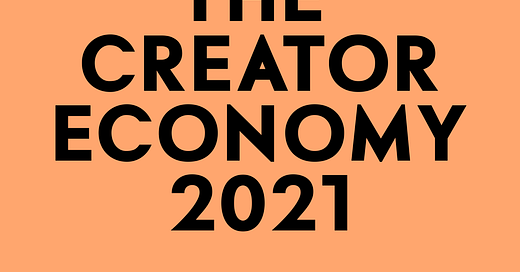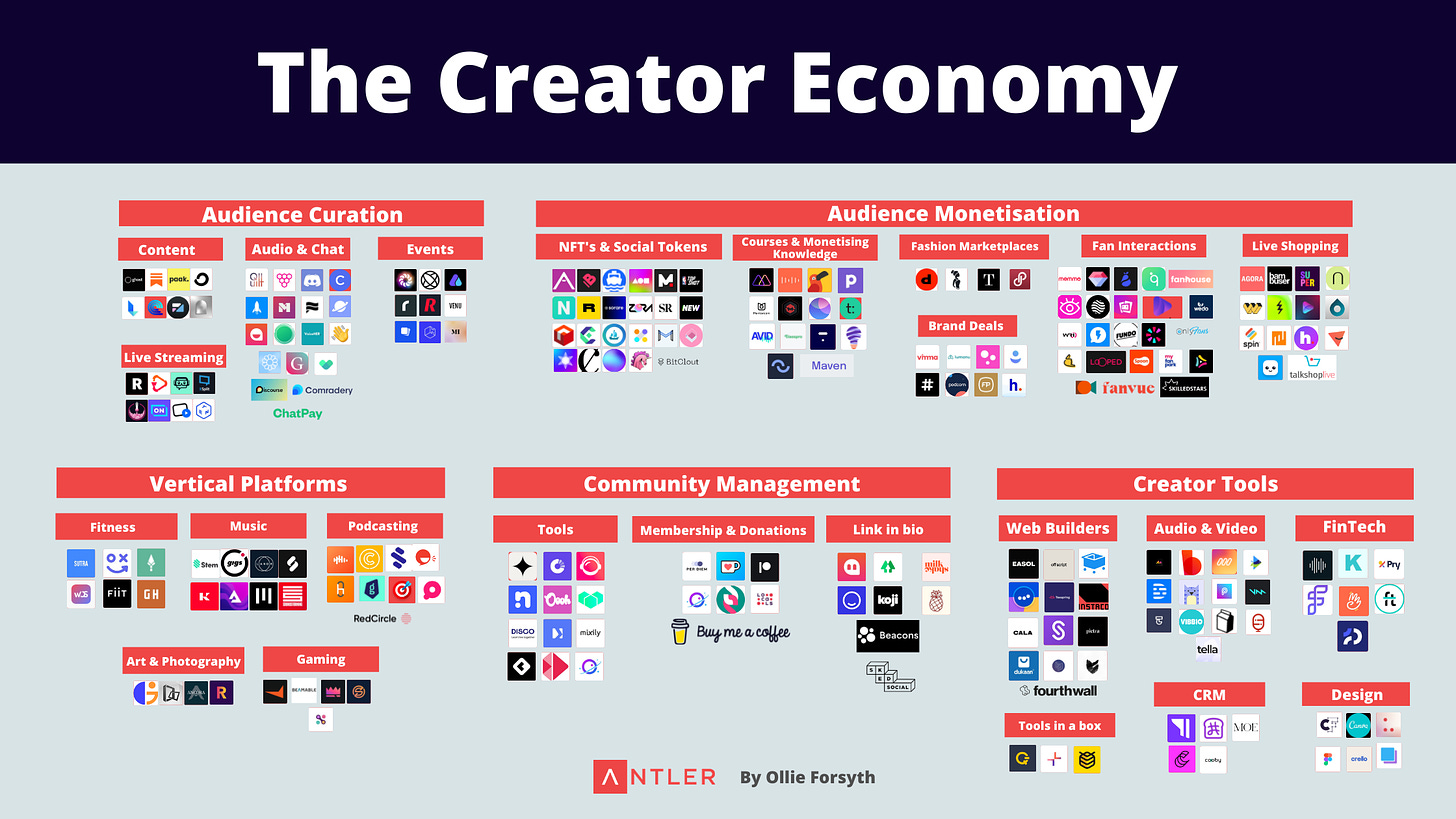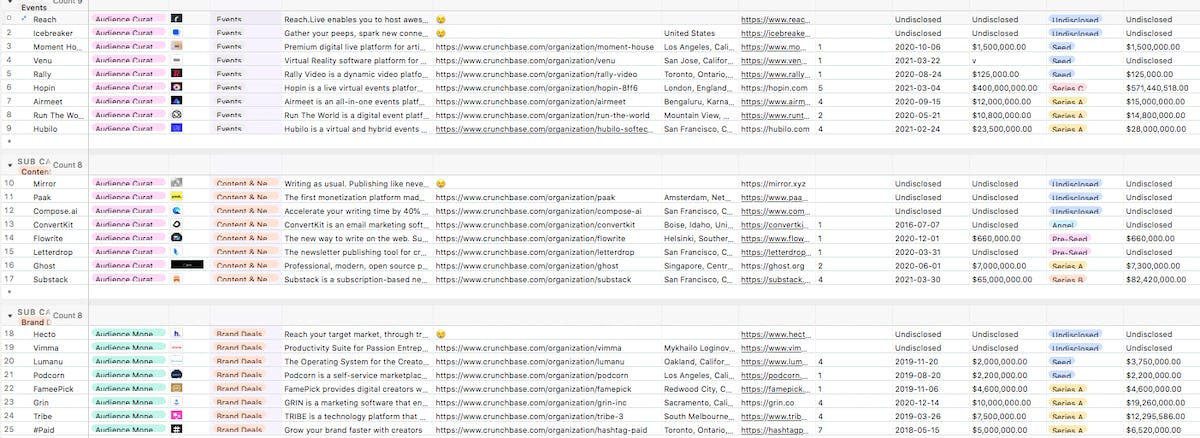The ultimate guide to the creator economy
A comprehensive guide on the creator economy, featuring 200+ platforms that empower creators today. Learn how to turn your hobby into a paying profession.
The COVID pandemic has propelled the Creator Economy into a new era, fuelled by the upward trend of people monetizing their passions to make a living.
Last year, few European venture capitalists were focused on the Creator Economy space. Now, the majority of VCs we work with are pursuing deal flow in this booming sector.
This piqued interest in the Creator Economy coincides with a notable shift in GenZ's career aspirations. As many as 29% of American students no longer want to become bankers, doctors, or lawyers. Instead, they aspire to become creators. At current rates, this trend could see a generational shift in the global workforce.
Here's why Gen Z will drive that change:
• They want to have the flexibility to work and live anywhere in the world
• They want full autonomy over their day-to-day agenda
• They want to make an income by doing what they truly love
• They want happiness and limited stress in their lives
To help you navigate this new economy and make the most of the new business born from it, we have mapped out the 220+ platforms that are empowering creators to make an income by doing what they love.
In mapping out the Creator Economy, we cover five main categories: audience curation, audience monetization, vertical platforms, community management, and creator tools.
We've also leveraged insights and opinions from dozens of industry leaders from founders, employees, creators, and investors from the likes of Shopify, Stripe, Greylock Partners, Northzone, Index Ventures, Atomico, Snapchat, TikTok, Slow Ventures, Mighty Networks, Product Hunt and Hustle Fund.
So, here you have it --
What is audience curation?
The platforms that are enabling creators to build foundational audiences. This allows creators to turn casual fans into super fans.
What are examples of some platforms?
Within this category, there are four main sub-sectors:
• Audio & Community Chat - Platforms that allow creators to interact with their audience by chat or audio.
Examples: Bunches, ChatPay, Circle, Clubhouse, Community, Comradery, Disciple Media, Discord, Discourse, Guild, LaunchPass, MightyNetworks, Quilt, Quorum, Space, Tribe, Vibely, VoiceHER
• Content & Newsletters - Platforms that allow creators to produce written content.
Examples: Compose.ai, Letterdrop, Flowrite, Mirror, Paak, Substack, Ghost, ConvertKit
• Event platforms - Platforms that allow creators to host events.
Examples: Run The World, Rally, Moment House, Hopin,Airmeet, Icebreaker, Reach, Venu3d, Hubilo
• Live streaming - Platforms that allow creators to go live to their audience.
Examples: OnJam, Pipeline, Restream, Stage Ten, Stream Elements, Streamlabs, Unscreen, XSplit, Wedo
According to a number of industry leaders in the space, the main challenge that exists within audience curation is the ability to empower creators to commercialize their content and unlock value.
Rex Woodbury, an investor at Index Ventures says, "Creating and earning income are often not aligned. We're seeing this change (particularly with a shift in business models away from advertising) but a creator's effort isn't always rewarded with monetary value. And because there's little infrastructure or social safety net built for this type of work, creators can face mental health challenges or burnout."
Edwin Wee, Chief Millennial Officer at Stripe says, "When somebody becomes a creator, they're challenging the status quo. Many creators start as amateurs and there should be more platforms out there to help them become professionals and make a living out of content creation."
Eze Vidra, Managing Partner at Remagine Ventures sums this up well: "Anyone can download a TikTok video or copy it, forward a newsletter or share ‘exclusive' images with friends on Whatsapp. In music for example, the labels would go to great lengths to collect royalties for music in YouTube videos (how much of it actually goes to the artist is a different story), but creators have to fend for themselves."
Simultaneously, there are some big opportunities at play within this space as we move into what Woodbury describes as "the decade of belonging".
"People are tired of performing online and they want deeper, more intimate connections," he says.
"As more people come online (there are now 4 billion internet users), what seem like niche communities can become surprisingly large. I'm interested in how creators can build and cultivate their own communities, and how content platforms can better enable the long tail of creators. We'll see more robust tools and infrastructure emerge for content and community management."
What is audience monetisation?
The platforms that support creators to monetize their audience once they have a following. These types of platforms support creators to turn their audience from casual fans into super fans as well as their true fans.
What are examples of some platforms?
Audience monetization consists of four main types of platforms:
• Courses - Platforms that support creators to launch their own courses.
Examples of platform infrastructure include AAvid, Classpro, Float, Mana, Maven, Podia, Teachable, Thinkific, Virtually, and examples of monetizing knowledge (tutors) include 3Veta,Anyone, Cambly, Mentor, Metafy.
• NFT's - Platforms supporting creators to create digital pieces of art and memorabilia. I recently wrote a piece on The Rise of Digital Ownership which can be read here.
Examples: Arkane, Bitski, Cargo, Cent, DeGacha, Foundation, Mintable, Minty, NBA Top Shot, Nifty Gateway, OpenSea, Rarible, Scout, Showtime, Sorare, SuperRare, Unifty, Zora
• Social Tokens - Platforms that let you buy a share in your favourite creators.
Examples: Bitclout, Creaton, NewNew, Rally, Roll
• Brand Deals - Platforms that automate and digitize the management of creators.
Examples: Tribe,Lumanu, Vimma, Podcorn, #Paid, Grin, Famepick, Hecto
• Live Shopping - Platforms that allow you to buy live & directly from creators.
Examples: Whatnot, Hive, Roombles, TalkShop, Spin, Pop Shop Live, PerformLive, Newness, Livescale, Lalabox, Dropd, Bambuser, Agora, Super Great
• Fashion Marketplaces - Platforms where you typically buy 2nd hand items.
Examples: Tradesy, Poshmark, Depop, Curtsy
• Fan interactions - Technologies that allow creators to become closer to their fans through live interactions.
Examples: Armsprime, Cameo, Class, Fanhouse, Fanvue, Fundo, Jemi, LitPic, Looped, Memmo, MyFanPark, Olekoo, OnlyFans, PearPop, Boohoo, Skilled Stars, Spoon, Streamloots, Superpeer, Wavium, Wr1, Zebra
While many agree that the infrastructure to enable creators to monetize their content is still sub-par, once it is developed, there will be a huge opportunity for them.
"I'm most excited about the ability for creators to own direct relationships with their end consumers," says Pippa Lamb, Partner at Sweet Capital. "Advantages include a more efficient economic transfer between creator and consumer (the fewer intermediaries, the better) and a more authentic customer relationship."
Similarly, the introduction of NFTs and social tokens means opportunities are opening up for creators.
As put by Sam Lessin, Partner at Slow Ventures: "Similar to the way early companies use VC capital to fuel growth, early-stage influencers should be able to build their platform much larger than it would have been otherwise with the help of investment dollars. Think about how much more valuable Michael Jordan would be if he had investment dollars to invest in his brand earlier on."
Ryan Lee, Creator Monetisation at TikTok, says, "Social tokens will bring a new framework, alongside a new set of tools and opportunities, for how the relationship between creators and fans can exist and evolve. Tokens will span across platforms and countries to create a truly global marketplace for a creator's community."
Ryan Hoover, Founder of Product Hunt says "Social tokens unlock new opportunities for people and communities to collaborate which mutually benefit in the network's success."
Wendy Xiao Schadeck, Investor at Northzone says "Monetization channels haven't fully solidified because the individual business models are still very fragmented, outside of big social platforms, which only support advertising (not a great business for creators)."
Elizabeth Yin, Investor at Hustle Fund says "The creator economy is a new segment of entrepreneurship that is still in its early days. Today there are still not great ways to monetize outside of ads (of some sort). But when you think about it, creators have large audiences and have the opportunity to help other startups with distribution. I'm bullish on their ability to be investors themselves."
Jim Shepherd, Head of Talent Partnerships at Snapchat is also seeing this. "Creators now have so many different options and opportunities on how they can grow or monetise their audiences," he says. "For creators to be able to capitalise on their true individuality, we must support them in being discovered and continue to add creator tools to help them grow their empires.
"Snapchat works to provide Creators with meaningful audience growth opportunities - from Shows on Discover to showcasing their creativity to the entire community. In Q1 2021, over 120 million Snapchatters watched publisher and Show content on Discover from internet Creators. As of March 2021, Spotlight, Snapchat's entertainment platform for user-generated content, had 125 million monthly active users. This is not a wave, this is just the beginning."
What Are Vertical Platforms?
The platforms that are niche but potentially mega players. They focus on one vertical area for the creator, such as Fitness or Gaming.
What are examples of some platforms?
For this, we have mapped our five different types of vertical platforms.
• Art & Photography
Examples: Ancora Art, Gump, Kunstmatrix, Rialtos
• Music
Examples: AAudius, Gigs, Kobalt, Landr, Soundstorming, Splice, Stem, United Masters
• Fitness
Examples: Fiit, Playbook, Sutra, Trybe, Wos
• Gaming
Examples: Beamable, Faceit, Lowkey, Nexus, Shotcall
• Podcasts
Examples: CCastbox, Castup, Fireside Chat, Glow, Hubhopper, Podding, RedCircle, Sounder.FM, Vokl
While it's still up for debate as to whether vertical platforms will be the big winners against all-in-one platforms, Carmen Rico, Partner at Blossom Capital believes "that the Creator's Economy is such a huge opportunity that there's room for many platforms to own the space and that those platforms will be verticalized (up to a degree as a lot of it blends, e.g. cooking and travelling can both fit under entertainment)."
Carmen continues, "I'm also a big fan of focus and so I believe that even if they then expand into other verticals, finding PMF and scalability in one vertical first is the way to go."
And according to Beata Klein, Investor at Creandum, the growth of vertical platforms is only just beginning.
"There are already specific tools e.g gaming, but it is likely we will see a proliferation of solutions better targeted for an initial niche e.g for fintech creators, edtech creators, e-commerce creators, music creators, etc," she says.
What Is Community Management?
The platforms that support creators to own their audience.
What are examples of some platforms?
There are three main ways to manage communities. These include:
• Community Tools - These allow your community to be more integrated and manageable.
Examples: Commonroom, Commsor, Disco, Dots, Ensemble, Garnet, Laylo, Lu.ma, Mixily, Newcon, Notify, Oooh TV, Orbit, The Labz
• Link in bio - These platforms allow you to integrate all of your websites and social media links in one place.
Examples: Koji, Sked, Mona, Milkshake, Linktree, Flooz, Beacons, Snipfeed.
• Membership platforms - These are used for recurring and regular payments.
Examples: Buy me a coffee, Ko-fi, Patreon, Per Diem, SubscribeStar, Supercast.
Many in the industry are very excited about this part of the Creator Economy and how innovation of community platforms will empower middle-class creators and completely change the landscape.
"I see a power curve in the distribution of money: a few creators making fortunes, many making a side income. But how cool would it be to see a big fat middle-class of creators making a decent salary? That would allow people to make a living off of their skills and talents that might not be rewarded otherwise. A win-win situation," says Kevin Indig, Director of SEO at Shopify.
And what's most powerful about community, in this respect, is that a small or niche group of fans can be just as important as hundreds.
"Creators don't need world domination, they just need a micro niche with a strong community, says Mac Reddin, founder of Commsor. "Creators also have the ability to experiment with new things more, so we're seeing interesting takes on community springing up in the creator space with things such as NFT, social money, new platforms, etc."
What Are Creator Tools?
These are tools that creators can use to build and grow their businesses.
What are examples of some platforms?
The platforms disrupting this space include:
• Audio & Video
Examples: Aria, Biteable, Descript, InVideo, Kapwing, Milk, Mojo, PicsArt, Spext, Tella, Type Studio, Vibbio, Voicemod
• CRM systems for creators
Examples: Moe, Clout Jam, Cooby, Chord, Pico
• Design tools
Examples: The Landing, Figma, Snappa, Canva, Creative Fabrica
• FinTech tools including creator banks & support with payments.
Examples: Earnr, Fairmint, Friz, Lance, Karat, Payosu, Pry,ReleasePlan
• Website builders
• Tools in a box including analytics
Examples: Stir, Streambee, Queue
Mike Duboe, Investor at Greylock Partners says, "In many parts of the world, setting up a physical store remains the predominant way of trying one's hand at entrepreneurship. The modern wave of online commerce infrastructure has removed so much friction involved in setting up an online storefront -- it's exciting to think about the impact to a whole class of potential merchants once one can turn an insight into a storefront into revenue in a matter of minutes."
On this, Katie Kim, Investor at Forward Partners says, "The Creator Economy is massive. Every one of us has contributed to it. Anyone with a passion can become a creator. However, not everyone has the entrepreneurial skillset to manage and scale their audience base and build a wildly successful personal brand.
"Meanwhile, consumers face content-overload and fledgling businesses lose eyeballs and ears to the creators at the top of the pyramid--no matter how much money gets thrown at paid ads. Commerce web tools & platforms contribute to levelling out the playing field for the entrepreneurs in the middle. It alleviates the pressure off of some of them so that they can focus on doing what they know best and love most: creating."
From the insights provided above, it's clear the creator economy is not going anywhere anytime soon. However, for widespread success and scale, platforms must do more to support the middle class of creators. From discoverability to financing, reduced take rates on the amount they charge the creators for using the platform, and back-end office support such as legal, protection and support. Doing so will enable creators to blossom.
Be that as it may, this is an incredibly exciting space. As the attention spans of consumers declines, we are seeing a shift away from the creative and entertainment giants such as Netflix, Apple Music and Spotify, towards independent creators, who are literally making money off their passions from anywhere in the world, often just using a smartphone. As popularity and acceptance in society increase, the impact this segment has on economies and GDP is going to be significant.
This is just the beginning and as Sarah Guemouri an Investor at Atomico says, "it is exciting to see some category-defining companies emerge with Substack or Patreon latest round cementing their path to become $B+ companies."
I'm excited to see which platforms become the next unicorns!
If you have enjoyed this piece, check us out on Product Hunt!
Follow me on Substack and apply to Antler to build a defining company of tomorrow.







Hi, Ollie. I know this post has some years, but it still looks very interesting. Can we translate part of it into Spanish with links to you and a description of your newsletter?